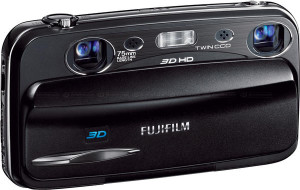How Does 3D Camera Work
With 3D becoming big business in the cinemas, it was only a matter of time until the consumer market demanded the ability to capture the third dimension, too.
A number of camera manufacturers have come up with ways to create 3D images including software and lens solutions, but only one camera is currently available to the consumer market that can produce a ‘true’ 3D image.
The Fujifilm FinePix Real 3D W3 can produce at rue 3D image because of its unique dual lens and sensor design. The two lenses are set approximately the same distance apart as a pair of human eyes -mimicking the sense of depth that we get when we view things with our own eyes.
The twin lenses capture two images simultaneously – similar to how your right and left eye would ‘see’ two different images – and the 3D processor converts these two images into a single 3D image file. By layering the two 2D images on top of one another, the camera is able to create one single stereoscopic 3D image with depth, or the allusion of it.
The 3D effect is created by taking two images from two lenses, creating a parallax effect. Parallax occurs from viewing an object along two lines of sight – try holding a pencil up in front of your eyes, then close one eye and then the other to see the pencil shift slightly each time.
 To achieve the best 3D effect, some subjects work better than others. For instance, the camera will only work in landscape orientation. Images taken with the camera in a vertical orientation are more difficult as your eyes cannot adjust to the parallax (as it is at a 90 degree angle). Images with some depth will work better -for instance those photos with subjects at two metres, five metres and eight metres -while macro shots, night time images and compositions where the subject is near the edge of the frame will not be as effective.
To achieve the best 3D effect, some subjects work better than others. For instance, the camera will only work in landscape orientation. Images taken with the camera in a vertical orientation are more difficult as your eyes cannot adjust to the parallax (as it is at a 90 degree angle). Images with some depth will work better -for instance those photos with subjects at two metres, five metres and eight metres -while macro shots, night time images and compositions where the subject is near the edge of the frame will not be as effective.
However, it is not the creation of 3D images that is problematic, but more the displaying of them. But with 3D-ready TVs making an appearance on the market, 3D solutions from other camera manufacturers are sure to follow suit.
Does 3D really work?
Is there any way to properly view your images?
 3D images taken with any 3D consumer camera can be viewed on a 3D-ready TV, via special 3D prints or on the back of the camera (in the case of the Fujifilm camera). In order to create the illusion of depth and a better 3D image, composition is important and setting up a shot with elements in the foreground, midground and background achieves the 3D effect best. Each stage of the image seems to float on its own layer and projects out towards the viewer. Images are best viewed straight on, while holding the camera at an angle disturbs the 3D look.
3D images taken with any 3D consumer camera can be viewed on a 3D-ready TV, via special 3D prints or on the back of the camera (in the case of the Fujifilm camera). In order to create the illusion of depth and a better 3D image, composition is important and setting up a shot with elements in the foreground, midground and background achieves the 3D effect best. Each stage of the image seems to float on its own layer and projects out towards the viewer. Images are best viewed straight on, while holding the camera at an angle disturbs the 3D look.
While the technology works exceptionally well, presently 3D consumer cameras are hindered by the way you view the images after capture. 3D prints are expensive and time-consuming to produce, 3D TVs are still in their infancy and viewing images on the back of your camera has its drawbacks too.

